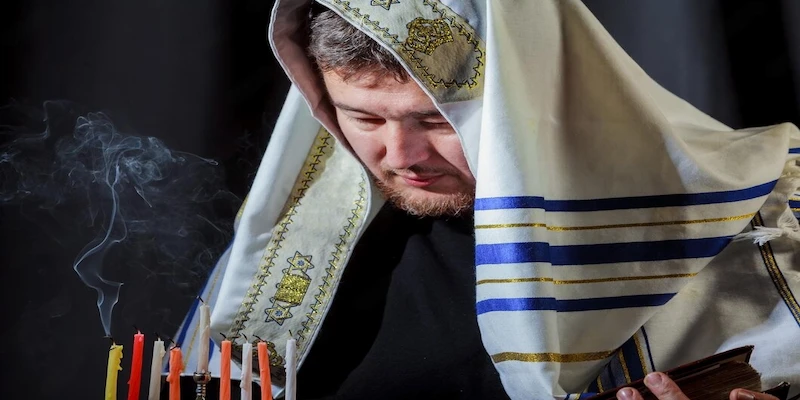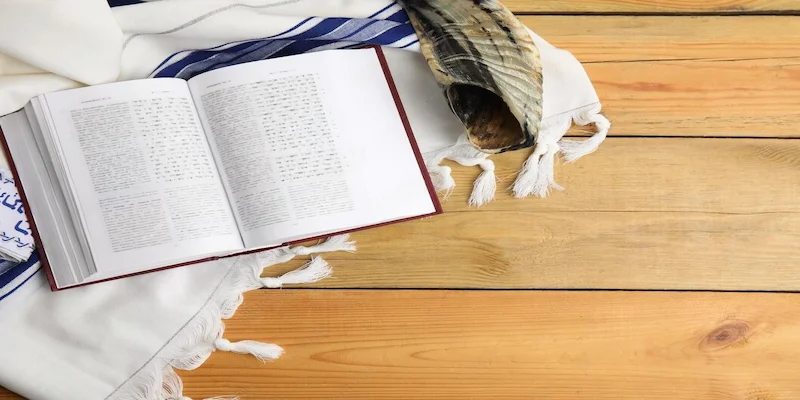Exploring the Meaning and Importance of the Jewish Prayer Shawl
Updated: July 16, 2024
71
The Jewish prayer shawl understood as the “tallit,” is a powerfully symbolic attire unraveled by Jewish men and, in some districts, by women during prayer. It means a physical relationship to faith, reminding the wearer of God’s commandments and their spiritual duties. The tallit is a religious garment that circles the person in a spiritual embrace, improving the reverence and love during prayer.
Brief History of the Prayer Shawl and Its Cultural Importance
Unraveling a prayer shawl dates back thousands of years, invested in age-old Jewish customs and spiritual practices. The tallit has grown but has stayed a central feature of Jewish worship and originality. It is a personal item of faith and a cultural relic that signifies belonging to Jewish society.
Origins of the Jewish Prayer Shawl
Biblical References to the Use of Prayer Shawls in Jewish Worship
The sources of the prayer shawl can be outlined in the Torah, where the commandment to sport fringes (tzitzit) on the intersections of apparel is found in the Book of Numbers (15:37-41) and Deuteronomy (22:12). These quotes teach Israelites to connect edges to their dress as a reminder of God’s commandments, thus setting the foundation for the prayer shawl custom.

Evolution of the Prayer Shawl Over Time
Originally, tzitzits were connected to regular dress, but over time, the tradition grew into making a specific garment—the tallit. This expansion authorized a more specified and intentional presentation of the commandments. The invention and use of the tallit have restarted to evolve, echoing changes in Jewish culture and religious tradition while keeping its core importance.
| Prayer lines for Jewish prayer shawl |
|---|
|
Guidelines for Wearing the Shawl During Prayer Services
During prayer services, the tallit is generally worn throughout the morning prayers, including repeating the Shema and the Amidah. It is expected to keep the tallit on until the back of the benefit, although some may release it after the Torah lesson. The tallit is usually not worn during afternoon and evening devotions, save on Yom Kippur; it is sported throughout the day.
How to Wear a Jewish Prayer Shawl
Step-by-Step Guide on How to Suitably Put On and Wear a Blessing Shawl
- Preparation: Confirm the tallit is neat and in good condition.
- Blessing: Before setting on the tallit, repeat the prayer: “Baruch Adonai, Eloheinu Melech, asher levitated tzitzit.” (Gifted are You, Lord our God, King of the heavens, who has blessed us with His commandments and hailed us to cover ourselves in tzitzit.)
- Draping: Keep the tallit available and drape it over the shoulders, letting it cover the back and swing down.
- Adjusting: Take the two ends and adjust the tallit to fit comfortably. Some people cover their heads briefly with the tallit as a sign of reverence.
- Securing: Many sport the tallit to stay in place by tucking it in or permitting it to drape willingly.
Variations of the Jewish Prayer Shawl
Different Styles and Designs of Prayer Shawls Used by Various Jewish Communities
Different Jewish communities have distinct styles of tallit, for example.
- Ashkenazi Tallit: Typically white with black or blue stripes.
- Sephardic Tallit: Often features white-on-white designs or colorful embroidery.
- Modern Variations: Some contemporary tallitot incorporate a variety of colors and artistic designs, reflecting the wearer’s individuality.
Special Prayer Shawls Used for Specific Occasions or Ceremonies
Special tallitot is occasionally used for special occasions, such as marriages, bar mitzvahs, or other important life occasions. They may be handed down as family artifacts or gifted to mark particular landmarks.
Modern Variations and Practices of the Jewish Prayer Shawl
Current Attitudes on the Use of Prayer Shawls in Jewish Worship
Currently, the tallit persists as a meaningful practice in Jewish worship. While traditions are born, people are also exposed to personalizing and adjusting the tallit to echo stylish spiritual traditions.
Creative Ways in Which Individuals Incorporate the Prayer Shawl into Their Spiritual Practice
Many individuals incorporate their talents into their daily lives beyond formal prayer services. Some use the tallit during private meditation or study, while others integrate it into family traditions and celebrations. Personalized tallitot, with unique designs and inscriptions, are becoming increasingly popular to express individual faith and creativity.

Types of Jewish Prayer Shawls
Different Styles and Designs of the Tallit
The tallit has various styles and designs, reflecting different cultural and religious traditions. Some tallitot are simple and white, with black or blue stripes, while others may feature intricate embroidery, colorful patterns, and decorative Atarah (neckbands). The design choice often reflects personal or familial preferences and the customs of specific Jewish communities.
Variations in Materials and Colors Used for the Prayer Shawl
Tallitots can be made from a variety of fabrics, including wool, cotton, silk, and artificial wool. Customary tallitots are usually white with low or black lines, but modern interpretations may include various colors and fabrics to suit personal tastes. The Atarah, or choker, is occasionally decorated with silver or gold needlepoint, adding extra beauty and value to the apparel.
Importance of the Fringe (Tzitzit)
Its most important feature is the fringes, or tzitzit, on the tallit. The piece fringe includes several strands secured absolutely with messes and windings with deep symbolic meaning. The tzitzit reminds the wearer of the 613 commandments in the Torah and symbolizes faith and dedication to Jewish law. It represents the wearer’s responsibility to live holy lives and keep to God’s commandments.
Connection to Jewish Beliefs and Traditions
The tallit, with its creases, symbolizes the Jewish people’s relationship to their faith and practices. It is a concrete indication of their covenant with God and a regular reminder of their spiritual duties. Sporting the tallit during prayer creates a sense of sacredness and concentration, allowing worshippers to enter a state of spiritual mindfulness and relationship to the religion.
Conclusion
The Jewish prayer shawl, or tallit, represents faith, practice, and society. It is a tangible reminder of spiritual duties and a link to Jewish origin. The tallit’s matter is profoundly implanted in biblical commandments and has become important to Jewish worship. Despite the changes in modern society, the tallit remains a central element of Jewish spiritual tradition. Its lasting relevance is a testament to the power and continuity of Jewish practice.
By welcoming the tallit’s recorded significance and modern adaptions, people can restart to find purpose and harmony in this old practice. Promoting the use and interpretation of the tallit helps keep its gift for coming years.
FAQs
What is a Jewish prayer shawl?
Jewish prayer shawl, or a tallit, is a religious garment sported by Jewish men during prayer. It is traditionally created of wool or silk and often features cosmetic fringes reached tzitzit.
Why do Jewish men wear a prayer shawl?
Wearing a prayer shawl is a classic method for Jewish men during prayer. It performs the commandment in the Torah to sport fringes on the intersections of their apparel. It is a symbol of God’s safety and a reminder of the Jewish people’s relationship to their beliefs.
When should a Jewish man wear a prayer shawl?
Jewish man generally wears a prayer shawl during morning prayer benefits and on certain events such as Yom Kippur and Passover. Some may also prefer to wear it during other personal devotion or study times.
Can women wear a Jewish prayer shawl?
While Jewish men traditionally unravel the prayer shawl, some women in more progressive communities have begun to wear them to describe their relationship to Jewish tradition and practice.
How is a Jewish prayer shawl different from a prayer scarf?
Prayer shawl is normally bigger and worn over the shoulders, while a prayer bandanna is smaller and usually worn about the channel. The two serve other drives in Jewish prayer.
Please Write Your Comments